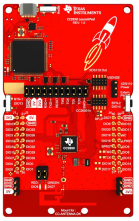SWRA475A January 2015 – October 2016 CC2540 , CC2540T , CC2541 , CC2541-Q1
3.1 Development Kits
Getting started with designing a beacon first involves the decision of which development kit to use. The CC2650 LaunchPad, which is shown in Figure 9, is the recommended platform for Bluetooth low energy beacons. The sample projects mentioned in this application note run on the CC2650 LaunchPad. More information about this and other development kits can be found at ti.com/ble.
The development kits can be purchased online at TI store[5].
